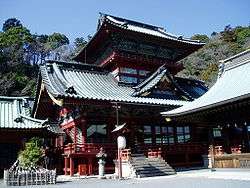Shizuoka Sengen Shrine
| Shizuoka Sengen Jinja 静岡浅間神社 | |
|---|---|
|
Prayer Hall of Shizuoka Sengen Jinja | |
| Information | |
| Type | Asama shrine |
| Dedicated to |
Ohnamuchi-no-Mikoto Konohanasakuya-hime, Ohtoshimioya-no-Mikoto |
| Address | 102-1 Miyagasaki-chō, Aoi-ku, Shizuoka, 420-0868 |
| Website |
www |
|
| |
Shizuoka Sengen Jinja (静岡浅間神社) is the name for a collective group of three Shinto shrines now forming a single religious corporation, located at Mount Shizuhata in Aoi-ku, Shizuoka in Shizuoka Prefecture, Japan. These shrines are the Kambe Jinja (神部神社), Sengen Jinja (浅間神社), and Ohtoshimioya Jinja (大歳御祖神社). The main festival of the shrine is held annually on April 5.
Enshrined kami
The primary kami of Kambe Jinja is the Ohnamuchi-no-Mikoto, who is regarded as the mythical founding deity of Suruga Province.
The primary kami of Sengen Jinja is the Konohanasakuya-hime, the deity of Mount Fuji.
The primary kami of Ohtoshimioya Shrine is the Ohtoshimioya-no-Mikoto, who appears in the Kojiki as a daughter of Susano-o, and a kami protecting markets and commerce.
History
The date of the Shizuoka Sengen Jinja's foundation is unknown. The area has been inhabited since prehistoric times, and a Kofun period burial mound has been excavated at Mount Shizuhata. Per the Nihon Shoki, the area was colonized by the Hata clan during this period. According to unsubstantiated shrine legend, the foundation of the Kambe Jinja dates to the reign of Emperor Sujin, that of the Ohtoshimioya Shrine to the reign of Emperor Ojin, both from the Kofun period.
Per the Engishiki records, Kambe Jinja was given national recognition and status of the Sōja of Suruga Province in the Heian period. Also, the date of 901 is given for the foundation of the Sengen Jinja, as a subsidiary branch of the Fujisan Hongū Sengen Taisha, and initially was referred to as the "Shingu" (new shrine).
Through the Kamakura and Muromachi periods, the shrines enjoyed the patronage of the powerful warrior clans who dominated the Suruga area: the Minamoto clan, Hojo clan, Imagawa clan, Takeda clan and the Tokugawa clan. In particular, the first Tokugawa Shōgun, Tokugawa Ieyasu, sponsored the rebuilding of the shrines after his retirement to nearby Sumpu Castle, and subsequent Shogun continued to worship at the shrines throughout the Edo period. The 3rd Shōgun, Tokugawa Iemitsu granted the shrines lands with 2313 koku in revenue for their upkeep. However, the shrine complex burned down in a fire of 1804. It was rebuilt over a 60-year period at a cost of over 100,000 gold ryō by the Tokugawa Shogunate in the its flamboyant Momoyama style, with extensive use of lacquer, wood carvings, and gold leaf. Today, 26 structures in the shrine complex are protected by the national government as Important Cultural Properties, forming one of the largest such complexes in the country.
In the modern system of ranked Shinto Shrines, Shizuoka Sengen was listed among the 3rd class of nationally significant shrines or Kokuhei Shōsha (国幣小社).
Subsidiary shrines
In addition to the three main shrines, the Shizuoka Sengen Jinja complex also has four subsidiary shrines:
- Hayama Jinja (麓山神社) dedicated to Ōyamatsumi-no-Mikoto and to Yamato-takeru. It was founded in 1878
- Yachiho Jinja (八千戈神社), an amalgamation of 18 small shrines and 13 small chapels found in the surrounding area. It was founded in 1873.
- Sukunahiko Jinja (少彦名神社), formerly the Yakushi-do of Kambe Jinja, turned into a shrine in Meiji period due to separation of Buddhism from Shinto.
- Tamahoko Jinja (玉鉾神) dedicated to the four main Edo period kokugaku scholars.
Cultural properties
Today, 26 structures in the shrine complex are protected by the national government as Important Cultural Properties (ICP), forming one of the largest such complexes in the country.
The shrine has a small museum, which displays finds from the Shizuhatayama Kofun archaeological site, artifacts pertaining to Tokugawa Ieyasu and the history of the shrine, as well as the shrine's non-structural ICPs, including a Muromachi-period tachi Japanese sword and 17 diagrams of the shrine prior to its late Edo-period rebuilding.
See also
Notes
References
- Nihon 100 no Jinja (19885). Nihon Kotsu Kosha, Tokyo
- Plutschow, Herbe. Matsuri: The Festivals of Japan. RoutledgeCurzon (1996) ISBN 1-873410-63-8
Coordinates: 35°07′19″N 138°55′08″E / 35.12194°N 138.91889°E
